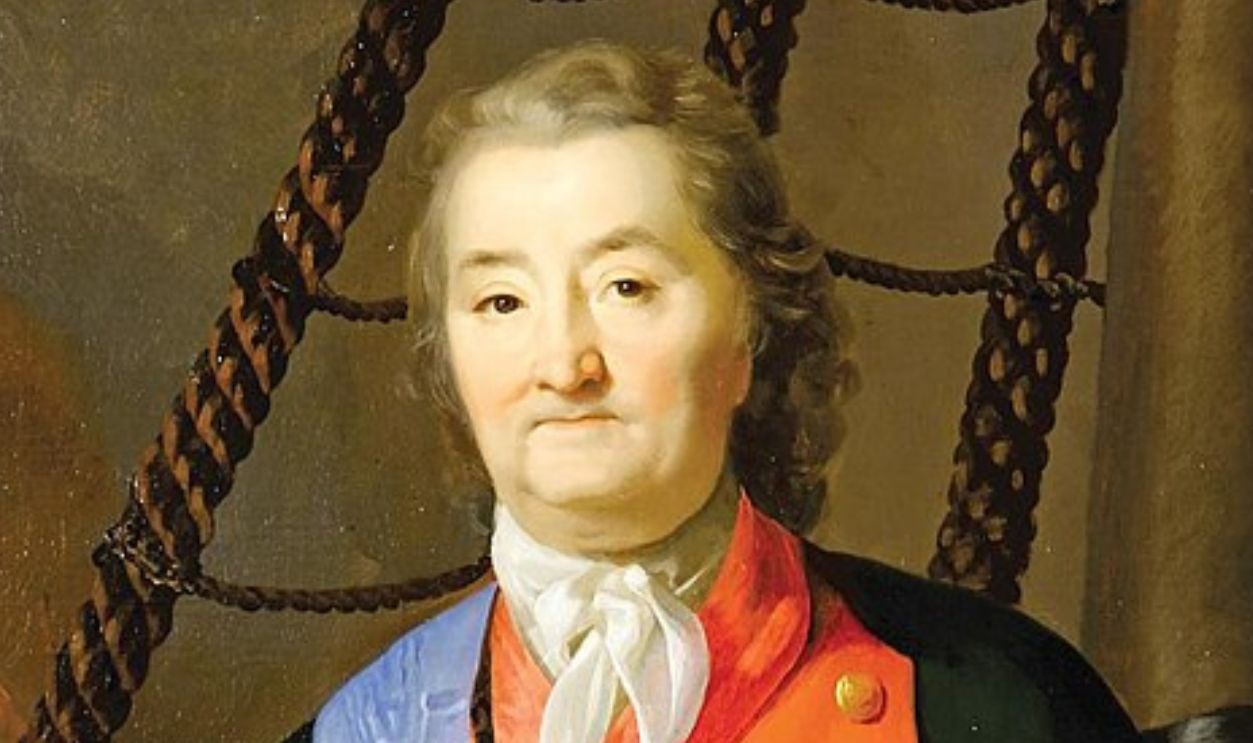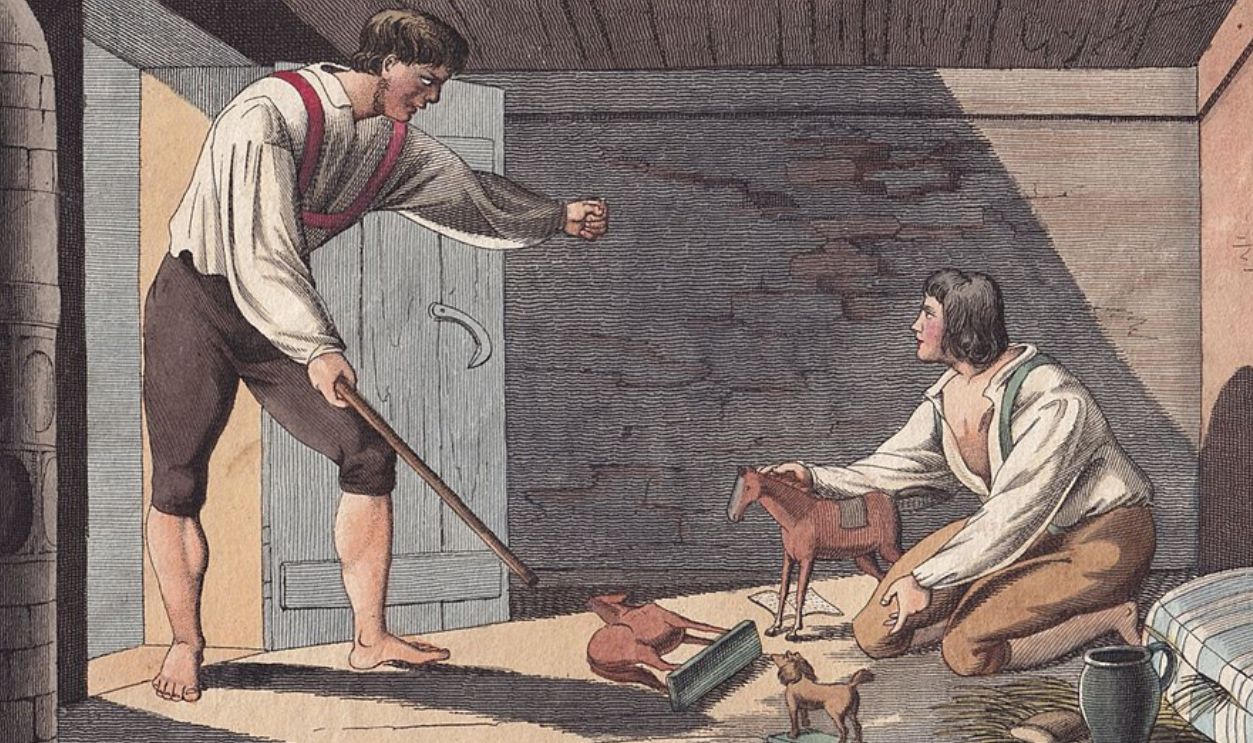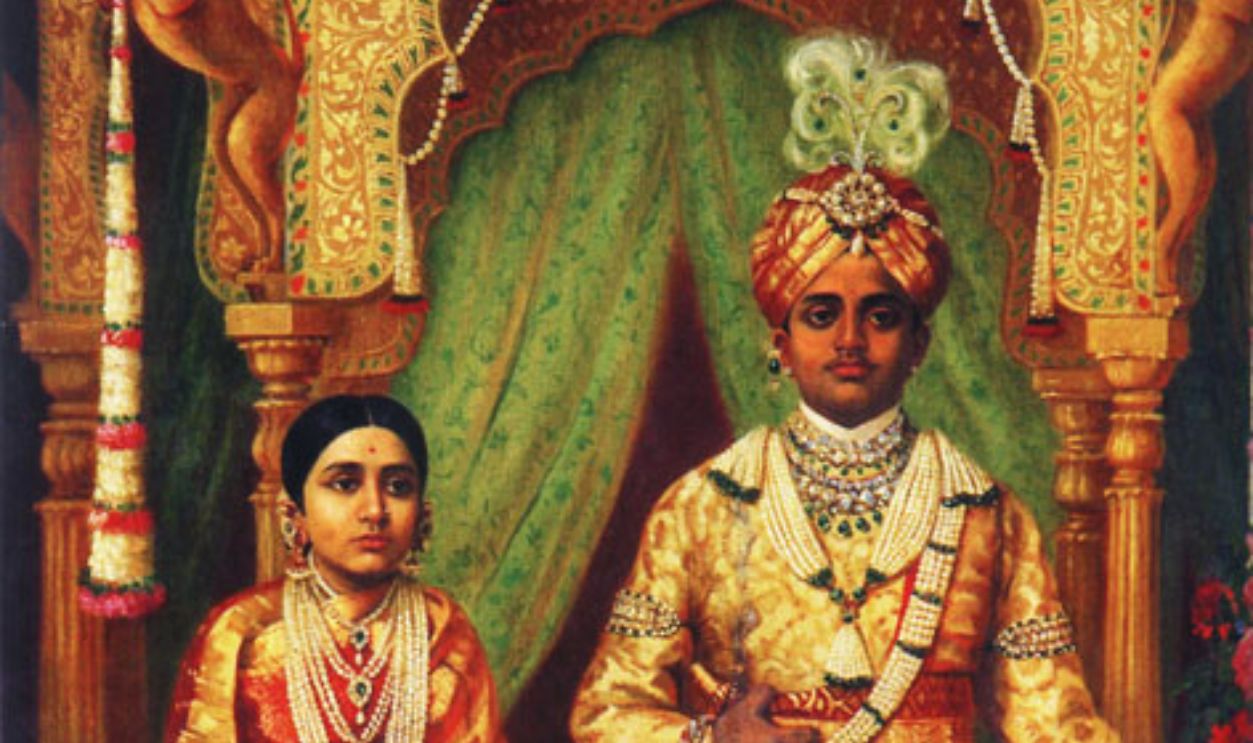Crown And Controversy
Kings and queens weren't always the picture of nobility, poise, benevolence, and class. Behind palace walls, royal families schemed, betrayed, and killed. This list consists of forbidden love affairs and plenty of power-hungry relatives.

Cleopatra's Sibling Rivalry Turns Deadly
Ancient Egypt's most famous queen didn't start at the top. After her father passed, 18-year-old Cleopatra was forced to marry her 10-year-old brother Ptolemy XIII to rule jointly. Their power struggle intensified when Ptolemy's advisers banished her from Egypt in 48 BCE.
 Smithsonian American Art Museum, Wikimedia Commons
Smithsonian American Art Museum, Wikimedia Commons
Cleopatra's Dramatic Return
Hidden inside a carpet and smuggled into Julius Caesar's quarters, Cleopatra made history's most theatrical entrance. The move worked brilliantly, and Caesar was instantly captivated. Their alliance sparked a civil war that ended with Ptolemy XIII drowning in the Nile.
 Tancredi Scarpelli, Wikimedia Commons
Tancredi Scarpelli, Wikimedia Commons
Ivan The Terrible Lives Up To His Name
In 1581, Russia's first Tsar proved why history remembers him as "Terrible". During a heated argument, Ivan struck his pregnant daughter-in-law, causing her miscarriage. When his son confronted him, Ivan struck again—this time fatally wounding his only capable heir with his royal staff.
 Viktor Vasnetsov, Wikimedia Commons
Viktor Vasnetsov, Wikimedia Commons
The Fall Of A Dynasty
Ivan's actions had catastrophic consequences. With his competent son no more, the throne passed to his mentally challenged younger son, Feodor. The once-mighty Rurik dynasty crumbled, and this led to the Time of Troubles—15 years of conflict and foreign invasion.
 Unknown Author, Wikimedia Commons
Unknown Author, Wikimedia Commons
The Purple-Born Emperor's Deadly Game
Byzantine Emperor Constantine VI shocked the empire by blinding his own mother, Irene, in 797 CE. The twist? She struck back first, organizing a coup that left him without eyes and dying in agony. His mother became the first woman to rule Byzantium solo.
 Wilfredo Rafael Rodriguez Hernandez, CC0, Wikimedia Commons
Wilfredo Rafael Rodriguez Hernandez, CC0, Wikimedia Commons
A Mother's Ruthless Rise
Statistics paint a grim picture—Irene's five-year reign saw treasury reserves drop by 50%. While wearing magnificent jeweled robes, she imposed crushing taxes on peasants. Charlemagne nearly married her to unite East and West, but her nobles overthrew her first.
Emperor Nero's Mommy Issues
Another one who hated his mom! Roman Emperor Nero tried killing his controlling mother, Agrippina, three times. First, he poisoned her food—she had an antidote. Next, he rigged her bedroom ceiling to collapse—she escaped. Finally, he sank her boat—she swam to shore.
 John William Waterhouse, Wikimedia Commons
John William Waterhouse, Wikimedia Commons
Fourth Time's The Charm
Nero finally succeeded by sending assassins to finish the job in 59 CE. Ancient sources claim Agrippina's last words were "Strike my womb", which had given birth to such a monster. The Senate congratulated Nero on "escaping his mother's plots".
 National Museum in Warsaw, CC0, Wikimedia Commons
National Museum in Warsaw, CC0, Wikimedia Commons
Catherine The Great's Inconvenient Husband
Russia's most famous empress had an unfortunate obstacle: Peter III, her husband. In 1762, just six months into his reign, Peter vanished. Catherine claimed he died of "hemorrhoidal colic". Suspiciously convenient timing, wouldn't you say?
 Georg Cristoph Grooth, Wikimedia Commons
Georg Cristoph Grooth, Wikimedia Commons
The Truth Behind The Throne
Guards at Peter's prison reported hearing violent struggles the night of his "illness". Catherine's lover, Alexei Orlov, later bragged about strangling the former emperor. The Empress ruled Russia for 34 years afterward, and she expanded its territory by 200,000 square miles.
 Hermitage Museum, Wikimedia Commons
Hermitage Museum, Wikimedia Commons
The Madness Of King Ludwig
Bavaria's King Ludwig II spent his kingdom's entire treasury building fairytale castles. His most famous creation, Neuschwanstein, cost 6.2 million marks (equivalent to $50 million today). The government declared him insane in 1886. Was it money well spent?
 Heinrich Georg Dendl, Wikimedia Commons
Heinrich Georg Dendl, Wikimedia Commons
A Mysterious End
Three days after being deposed, Ludwig's body was found floating in waist-deep water. His doctor's body floated nearby. Despite being an excellent swimmer, officials ruled it a suicide. The truth behind the "Mad King's" death remains disputed.
 Luise von Kobell, Wikimedia Commons
Luise von Kobell, Wikimedia Commons
Pedro I's Heart-Stopping Love
Portugal's crown prince, Pedro, fell hard for his wife's lady-in-waiting, Inês de Castro, in 1340. When his father had Inês executed, Pedro rebelled. After becoming king, he exhumed her corpse, crowned her queen, and allegedly forced the court to kiss her decomposed hand.
 Pierre Charles Comte, CC BY-SA 3.0, Wikimedia Commons
Pierre Charles Comte, CC BY-SA 3.0, Wikimedia Commons
An Executed Queen's Coronation
Pedro claimed he'd secretly married Inês before she was taken out. He executed her killers by ripping out their hearts because he claimed they'd torn out his by murdering her. Their tombs at Alcobaça Monastery were placed foot-to-foot so they'd see each other first on Judgment Day.
 Salvador Martínez Cubells, Wikimedia Commons
Salvador Martínez Cubells, Wikimedia Commons
Empress Zoe's Marriage Marathon
At age 50, Byzantine Empress Zoe discovered her husband Constantine VIII was spoiling her beauty potions. Quick thinking saved her; she adopted a handsome 24-year-old sailor named Michael. Within 24 hours, Constantine died mysteriously, and Zoe married her "son".
Age Is Just A Number
Michael IV lasted seven years before dying of guilt (or possibly more poison). Not one to waste time, 64-year-old Zoe married a third husband the same day she buried the second. The people of Constantinople rioted—they wanted their elderly empress to slow down.
 Unknown, 13th-century author, Wikimedia Commons
Unknown, 13th-century author, Wikimedia Commons
Queen Christina's Shocking Exit
Sweden's Queen Christina stunned Europe in 1654 by abdicating her throne. The real scandal? She converted to Catholicism, dressed in men's clothes, and rode horses like men during that time. Many whispered about her close "friendship" with a female court member.
 Sébastien Bourdon, Wikimedia Commons
Sébastien Bourdon, Wikimedia Commons
The Price Of Freedom
Christina's conversion cost her the Swedish crown, but she gained something priceless, which was independence. She moved to Rome, established a famous salon, and became a patron of the arts. The Vatican still displays her extensive art collection.
George III's Blue Blood Problem
Britain's King George III suffered from periods of madness of talking nonstop for hours, attacking servants, and trying to shake hands with trees. Modern analysis of his medical records suggests he had porphyria, a genetic blood disorder that turned his urine blue.
 Allan Ramsay, Wikimedia Commons
Allan Ramsay, Wikimedia Commons
A Kingdom In Chaos
During the king's worst episode in 1788, he spoke for 58 hours straight. The Parliament nearly replaced him with his son. The queen had to hide all the knives, and doctors treated him by blistering his skin and making him wear a straitjacket lined with leather.
 Allan Ramsay, Wikimedia Commons
Allan Ramsay, Wikimedia Commons
Empress Theodora's Scandalous Past
Before becoming Byzantine Empress, Theodora worked as an actress, a job considered only slightly more respectable than being a courtesan in 6th-century Constantinople. She performed dances sometimes with geese pecking grain from her body. The scandal? Emperor Justinian married her anyway.
 Meister von San Vitale in Ravenna, Wikimedia Commons
Meister von San Vitale in Ravenna, Wikimedia Commons
Love Conquers Law
Justinian changed Roman law just to marry Theodora. Previously, senators couldn't wed actresses. The power couple ruled as near equals for 21 years. They also crushed riots and built the magnificent Hagia Sophia. Scandal with a happy ending; no one saw that coming.
 Petar Milošević, CC BY-SA 4.0, Wikimedia Commons
Petar Milošević, CC BY-SA 4.0, Wikimedia Commons
The Habsburg Jaw
The Habsburg dynasty ruled much of Europe for centuries, but their power came at a price. Repeated intermarriage gave many family members a distinctive protruding lower jaw. By 1700, the Spanish branch was so inbred that King Charles II couldn't chew his food.
 Juan Carreño de Miranda, Wikimedia Commons
Juan Carreño de Miranda, Wikimedia Commons
The Last Habsburg
Charles II's autopsy revealed he had "a heart the size of a peppercorn, lungs corroded, intestines rotten and gangrenous". His passing in 1700 triggered the War of Spanish Succession. DNA studies show his inbreeding coefficient was higher than if his parents had been siblings.
 John Closterman, Wikimedia Commons
John Closterman, Wikimedia Commons
Isabella Of France: The She-Wolf
England's Queen Isabella took revenge on her neglectful husband, Edward II, in 1326. While he lavished attention on his male favorites, she raised an army in France. Her invasion succeeded, and Edward was forced to abdicate and later passed mysteriously in prison.
 Unknown Author, Wikimedia Commons
Unknown Author, Wikimedia Commons
A Hot End For A Cold Marriage
According to legend, Isabella's agents took out Edward II by inserting a red-hot poker through a hollow cow's horn. The method left no external marks. Isabella ruled as regent for three years until her son, Edward III, seized power and imprisoned her.
 Unknown Author, Wikimedia Commons
Unknown Author, Wikimedia Commons
The Mad Queen Joanna
Spain's Queen Joanna earned her nickname "The Mad," honestly. After her husband Philip's demise in 1506, she refused to bury him. For months, she traveled across Spain with his decomposing body, opening the coffin to embrace him and kiss his rotting feet.
 Marquard Wocher, Wikimedia Commons
Marquard Wocher, Wikimedia Commons
Love Beyond The Tomb
Joanna ordered Philip's tomb opened twice to check on him. Her father used her "madness" as an excuse to seize power and kept her confined for 46 years. Modern historians debate whether she was truly insane or just a convenient political prisoner.
 Rijksmuseum, Wikimedia Commons
Rijksmuseum, Wikimedia Commons
The Blood Countess Strikes
Hungarian Countess Elizabeth Báthory, who was related to several royal families, shocked Europe around 1610. Acting under noble privilege, she allegedly mistreated and ended the lives of 650 young women. Some accounts claim she bathed in their blood to maintain her youth.
 Unidentified painter, Wikimedia Commons
Unidentified painter, Wikimedia Commons
Justice With A Twist
Despite evidence from 300 witnesses, Báthory's royal status saved her from execution. Instead, she was walled up alive in her castle rooms for four years until she faced her end. Her family paid 4,000 florins in compensation—about $2 million today.
 Jacomoman78, CC BY-SA 3.0, Wikimedia Commons
Jacomoman78, CC BY-SA 3.0, Wikimedia Commons
Princess Sophia's Power Play
In 1730, Russia's 15-year-old Princess Sophia schemed her way to becoming Catherine the First. Planning with the Imperial Guard, she orchestrated her own engagement party, then arrested her young fiancé and his entire family during the celebrations.
 Hermitage Museum, Wikimedia Commons
Hermitage Museum, Wikimedia Commons
A Crown Well Played
Quick-thinking, Sophia changed her name to Anna and ruled Russia for ten years. She kept her former fiancé in prison, occasionally sending him fancy clothes and having him paraded through St. Petersburg in chains. Now, THAT is a bad breakup!
 Unknown Author, Wikimedia Commons
Unknown Author, Wikimedia Commons
Charles VI: The Glass King
France's King Charles VI became convinced he was made of glass in 1392. He refused to let anyone touch him because he feared he would shatter. Iron rods were sewn into his clothes to prevent "breaking", while courtiers tiptoed around their fragile monarch.
 Workshop of Jacob van Schuppen, Wikimedia Commons
Workshop of Jacob van Schuppen, Wikimedia Commons
Royal Padding Required
Charles insisted on wearing reinforced clothing at all times. During one famous episode, he ran through the palace for four days straight, refusing to stop or change clothes. The kingdom suffered through his 30-year reign of intermittent madness.
 Jean Perréal, Wikimedia Commons
Jean Perréal, Wikimedia Commons
The Mystery Of Kaspar Hauser
In 1828, a teenage fellow showed up in Nuremberg, claiming to be the kidnapped heir to Baden's throne. His story sparked international intrigue. He claimed that he had been switched at birth to prevent him from inheriting. DNA tests in 2002 finally disproved his royal claims.
 Johann Friedrich Carl Kreul, Wikimedia Commons
Johann Friedrich Carl Kreul, Wikimedia Commons
A Royal Wild Goose Chase
The boy's mysterious death from stabbing in 1833 fueled conspiracy theories. Five years of his life cost Baden's treasury 40,000 guilders, which is enough to feed 100 families for a year. Some called him Europe's most expensive impostor.
 Unknown Author, Wikimedia Commons
Unknown Author, Wikimedia Commons
Marie Antoinette's Diamond Disaster
The "Diamond Necklace Affair" helped trigger the French Revolution. In 1785, con artists used a Marie Antoinette look-alike to "purchase" a 2,800-carat diamond necklace. The queen knew nothing about it, but the scandal destroyed her reputation.
 Élisabeth Louise Vigée Le Brun, Wikimedia Commons
Élisabeth Louise Vigée Le Brun, Wikimedia Commons
Jewels And Justice
The necklace, worth 1.6 million livres (about $14 million today), was broken up and sold across Europe. When the truth emerged, it was too late, and the public believed Marie Antoinette had schemed to trick the jewelers. Revolution followed four years later.
Raja Wodeyar's Watery Revenge Legend
India's teen Raja Wodeyar used a creative method to seize power in 1610. He pushed his predecessor, Tirumala, into a deep well during a ritual ceremony, and he claimed it was an accident. The victim's widow cursed Wodeyar's line to remain childless—spookily, many of his successors were.
 Rajachandra at English Wikipedia, Wikimedia Commons
Rajachandra at English Wikipedia, Wikimedia Commons
The Price Of Power
According to legend, the curse was placed by Alamelamma, the wife of King Tirumalaraja, after Raja Wodeyar seized power in 1612. The family tried to break the curse through prayers and donations and they even spent millions of rupees on temples. Some say the curse lasted 400 years.
 Raja Ravi Varma, Wikimedia Commons
Raja Ravi Varma, Wikimedia Commons
Queen Carlota's Secret Scheme
Portugal's Queen Carlota tried hijacking South America in 1808. While her husband battled mental illness, she plotted to become "Empress of South America". She sent secret agents to Buenos Aires and offered to rule without her inconvenient spouse.
 João Baptista Ribeiro, Wikimedia Commons
João Baptista Ribeiro, Wikimedia Commons
A Queen Without A Kingdom
Spanish colonies rejected Carlota's power grab. Records show she spent 200,000 gold pesos (roughly $4 million today) on failed bribes. Her husband recovered enough to stop her schemes, though historians debate if he ever knew the full extent.
 Domingos Sequeira, Wikimedia Commons
Domingos Sequeira, Wikimedia Commons
Rome's Imperial Wedding Crasher
Emperor Elagabalus shocked Rome by marrying a Vestal Virgin in 220 CE. Vestal Virgins served for 30 years under pain of death if they broke their vows. He claimed the marriage would produce "godlike children". Spoiler alert: it didn't.
 Lawrence Alma-Tadema, Wikimedia Commons
Lawrence Alma-Tadema, Wikimedia Commons
A Short-Lived Scandal
The scandal lasted only months before both the emperor and bride were taken out. Their bodies were dragged through Rome's streets and thrown into the Tiber River. The empire spent 1 million sestertii (about $5 million today) on purification rituals afterward.
 Mr.Ajedrez, CC BY-SA 3.0, Wikimedia Commons
Mr.Ajedrez, CC BY-SA 3.0, Wikimedia Commons











